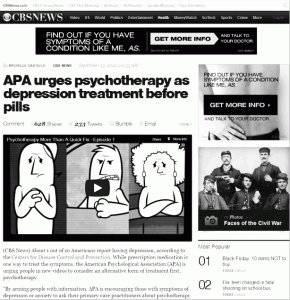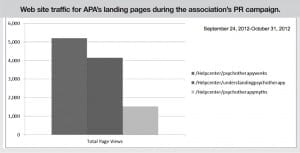
The Sandy Hook massacre late last year put the spotlight on a major issue: mental health. Although countless studies indicate that psychotherapy helps people living with depression and anxiety, drug therapy in the last decade has become the most popular treatment for people suffering from mental illness.
In order to balance that trend, the American Psychological Association Practice Directorate (APA) sought to educate consumers about psychotherapy’s effectiveness and encourage them to ask their physicians about it as a treatment option.
The organization tapped PR agency Vanguard Communications to help create an initiative to not only educate people living with depression and anxiety about their treatment options, but to inform primary-care providers about psychotherapy services, because they, too, need to be equipped to make a referral or answer patient questions about psychotherapy.
The result was the “Psychotherapy: More than a Quick Fix” campaign. The five-week digital PR and marketing program, which launched in October 2012 (Mental Health Month), was produced by a team of 20 PR pros, and had the following objectives:
1) Raise awareness among consumers about psychotherapy as a treatment option for depression, anxiety and stress.
2) Increase visibility of online educational resources to inform audiences about psychotherapy as a treatment option for the same conditions.
3) Drive audiences to APA’s Psychology Help Center and its Psychologist Locator service to learn more.
EXTENSIVE RESEARCH
Research revealed a trend showing that medication was outpacing psychotherapy as a first-line treatment for emotional and behavioral health conditions, despite evidence proving psychotherapy’s effectiveness. Audience research conducted annually for APA’s Mind/Body Health Campaign was leveraged to develop initial messaging and concepts for the initiative.
To generate feedback for the initiative, Vanguard hosted a discussion group with doctors from APA’s state psychological associations during one of APA’s annual meetings. APA members supported the need for an initiative about psychotherapy.
However, they counseled that primary-care providers were underinformed about psychotherapy. Being underinformed, while writing prescriptions and sending patients on their way, has led to an overmedicated population, they argued.
APA’s outreach efforts were in direct competition with the pharmaceutical industry’s marketing efforts, which are designed to promote medication as the desired treatment option for depression, anxiety and stress (with possible side effects).
APA had a major objective in needing to strike a delicate balance between educating the public about the effectiveness of psychotherapy as a treatment option, while at the same time not appearing to oppose medication as an effective intervention, especially when paired with psychotherapy.
Luana Bossolo, assistant executive director of PR for the APA, says the team knew that the media-relations strategy should not revolve around breaking news. “We knew some media would be doing feature stories in October for National Depression Awareness Week, which we could use, with a long lead up, to get on their radar,” she says.
The APA initiative launched on Sept. 24, 2012, in anticipation of National Depression Screening Day on October 11. It relied heavily on digital communications. Some of the specific tactics for the communications initiative included:
1) Creating two animated, informative digital videos about a fictional miracle drug called “Fixitol.” Developed in partnership with Free Range Studios and featuring a humorous tone, the two videos spoofed typical drug marketing.
2) Media Relations: Brandi Horton, integrated media strategist at Vanguard, says earned media was a critical component and extremely important to the success of the campaign.
Vanguard wrote and distributed a press release that was specially tailored for distribution of digital content, which, in turn, enabled embeddable video and direct links to a variety of digital assets.
3) Creating Content: The team included dedicated content and resources about depression and psychotherapy on APA’s Psychology Help Center page. “The videos are a good hook and where the eyeball will go first, but you can only go so deep in a one-minute animated video,” Horton says.
4) Social media: The online videos ran on the APA’s Facebook and Google+ pages, and its own campaign page on Twitter (@APAHelpCenter). Putting the videos on social channels was designed so people could share the videos with their own networks and encourage users to discuss the content. Viewers were also encouraged to tag messages on Twitterwith #therapyworks.
5) Developing electronic template media materials for use by psychologists locally. To supplement the media strategy, the team tapped into 50 state psychological associations. It also reached out to APA’s 1,000-member public education network and gave the network resources to activate local spokespeople who could then educate stakeholders at the local level.
The team provided multimedia pitch materials, email templates, press releases templates and a fact sheet showing that psychotherapy is an evidence-based treatment for mental health.
MEASURING UP
The team tracked quantitative measures, including Google Analytics for the APA website, video views and shares, Use of the #therapyworks hashtag and the quantity of earned media coverage. Specific PR results of the campaign include:
• The press release announcing the initiative and digital resources appeared on 299 websites and was viewed 1,700 times online.
• CBS News’ “Health Pop” blog featured the two videos while a radio media tour reached more than 1.8 million listeners across 838 airings nationwide.
• Both videos in the series garnered more than 20,000 combined views.
• In the first week the videos received more than 100 YouTube “likes” and 140 shares on Facebook reaching more than 28,000 unique visitors.
• Twitter reach of the #therapyworks hashtag reached more than 75,000 people with 112,786 impressions.
• The campaign generated 28,470 unique page views over five weeks.
Bossolo says that from a communications perspective, the most difficult aspect of the campaign was dealing with the pink elephant in the room: the pharmaceutical industry. The APA is nonprofit, with a $115 million annual budget, but that pales in comparison to the billion-dollar drug industry, according to Bossolo. “We knew we were going to have to be resourceful and do something unique,” she says.
If given a second chance, Bossolo says she would reconfigure the budget or conduct other PR efforts to make the humorous “Fixitol” videos have more of a viral effect. Horton says she would focus on partnering with a primary-care organization.
“We need to have those psychotherapist/primary-care provider relationships more in place to make things more robust and for us to continue to grow,” she says.
The next step for the campaign is to build upon the content this spring, with more nuanced messaging on how to help a family member or friend get the help they need by identifying signs of anxiety and stress in others, not just people themselves. PRN
CONTACT:
Luana Bossolo, @luanabossolo; Brandi Horton, [email protected].
Three Tips for Communicating Among Member Organizations
Social-marketing initiatives for nonprofits representing a profession, such as the American Psychological Association (APA), can benefit by engaging their members. APA made sure member engagement was part of the communications plan for their Psychotherapy Awareness Initiative in 2012. Lauana Bossolo, assistant executive director of public relations for the APA, provides three tips for engaging members in a campaign.
1. Seek members’ opinions: During the initial research phase, APA and Vanguard Communications staff not only did market research on their consumer audience, they conducted a focus group with psychologists to hear their point of view and test video concepts and messages. This was factored into the development phase. And, APA members felt they were being heard.
2. Ask for members’ help. During the content-development phase, APA asked psychologists to help with online content by interviewing them on various psychotherapy topics and having them review content before posting. And, APA acknowledged members’ contributions in materials. Members felt they were part of the process and felt they too had a stake in the initiative.
3. Tap members as ambassadors. One of the best ways to deliver information at a grassroots level is to engage members on the ground. APA developed tips, talking points and materials for psychologists to use locally and help spread the word about the psychotherapy initiative in their communities and to their colleagues.

